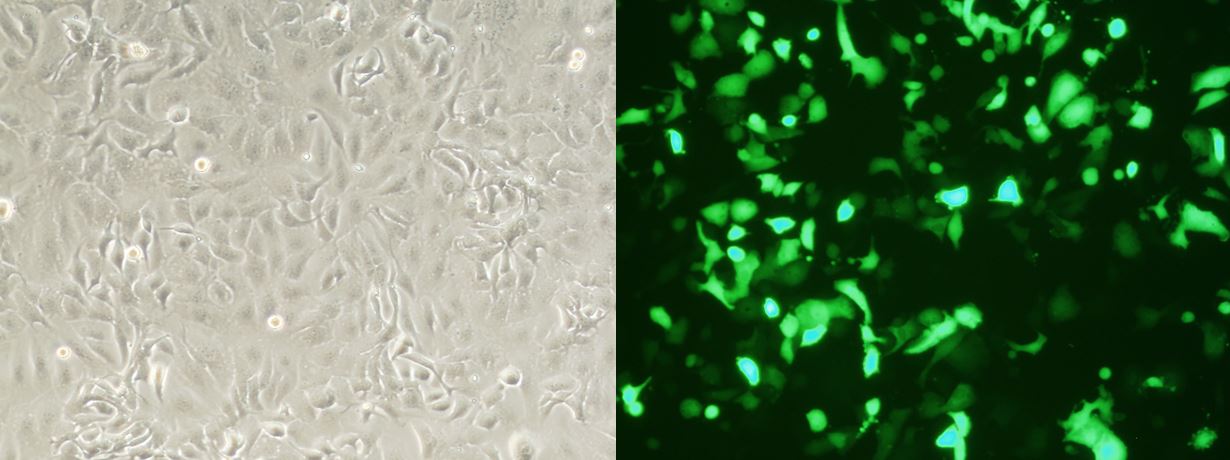Description
Cells to transfect:
Cell Line Name: NIH:OVCAR-3 (ATCC® HTB-161®) or OVCAR.3 or OVCAR-3
Cell Synonyms: NCI60, NCI-60, HTB-161, OVCAR.3, OVCAR-3
Organism: Homo sapiens, human
Tissue: ovary
Cell Type: epithelial
Culture Properties: adherent
Biosafety Level: 1
Disease; adenocarcinoma
Gender; Female
Ethnicity: Caucasian
Markers: androgen receptor, positive; estrogen receptor, positive; progesterone receptor, positive
Tumorigenic: Yes
Applications: This cell line is a suitable transfection host. It is an appropriate model system in which to study drug resistance in ovarian cancer. The presence of hormone receptors should be useful for the evaluation of hormonal therapy. Xenograft models have been used to show that treatment with 17 beta estradiol can induce progesterone receptors in this human ovarian carcinoma.
Comments: The NIH:NIH:OVCAR-3 line was established in 1982 by T.C. Hamilton, et al. from the malignant ascites of a patient with progressive adenocarcinoma of the ovary. Forms colonies in soft agar and has an abnormal karyotype. Resistant to clinically relevant concentrations of adriamycin, melphalan and cisplatin. Both cultured cells and xenografts exhibit androgen and estrogen receptors. NIH:OVCAR-3 is one of the cell lines of the NCI-60 panel which represents different cancer types and has been widely utilized for drug screening and molecular target identification.
Transfection reagent features:
- Broad spectrum for the transfection of large plasmid, mRNA, siRNA, and/or other type of nucleic acids, which is best for co-transfection of different type and/or size of nucleic acids.
- Unique formulation-maximize transfection performance in NIH:OVCAR-3 cells: transfection efficiency up to 90%
- Extremely gentle to cells: viability up to 95%
- Much less reagent needed for each transfection: 0.5 ml is able to transfect about 1000 wells of 24-well plate
- Free of animal-derived components
- Simplest and straightforward protocols to Increase experimental throughput
- Compatible with serum
- Suitable for Reverse Transfection
- Compatible with transfection in any plate format
- Economical: High efficiency means less amount of nucleic acid & reagent is needed
- Developed and manufactured by EZ Biosystems
Data®
FIG. 1. High throughput test of transfection efficiency (determined as RLU/mg) on NIH:OVCAR-3 cells after transfection of luciferase reporter gene by using our 172 proprietary transfection formulas and several most popular commercial transfection reagents. The yellow box showed the results of 4 commercial transfection reagents. The red lines marked our candidate formulas with the highest transfection efficiency for NIH:OVCAR-3 cells. This test result was confirmed with repeat experiments. The one that showed the optimal balance of potent & low cytotoxicity among those candidate formulas after flow cytometry analysis on the percentage of 7AAD positive cells was later named as this NIH:OVCAR-3 Cell Avalanche® Transfection Reagent.
FIG. 2. NIH:OVCAR-3 cells were transfected with GFP vector (pEGFP-N3) by using NIH:OVCAR-3 Cell Avalanche® Transfection Reagent. The cells were visualized by Nikon Eclipse Fluorescence microscope 24 hours post transfection.
For Other Cells
NIH:OVCAR-3 Cell Avalanche® Transfection Reagent (human ovary carcinoma cell) can also be used on the following cells with high transfection efficiencies.
IGROV-1 Cell
OVCAR-4 Cell
OVCAR-5 Cell
OVCAR-8 Cell
SK-OV-3 Cell
293 Cell
293T/17 Cell
Saos-2 Cell
Recommended protocols for these cells will be provided with the reagent. The protocols usually provide satisfactory transfection efficiency with invisible cytotoxicity. However, optimization may be needed for certain type of cells. Optimizations may include: the amount of DNA and this transfection reagent; cell density; transfection reagent/DNA ratio, or incubation time for the mixture of transfection reagent/DNA etc. For best transfection result, we recommend using the respective cell type/cell line specific Avalanche transfection reagents. Those reagents have been optimized on both recipes and protocols, and have been proved to have the best transfection results for the respective cell lines or primary cells. You can easily find the respective Avalanche transfection reagents specific for your cells by using the filters of our product list.
Additional Information
| Weight | 0.5 lbs |
|---|---|
| Adherence Phenotype | Adherent |
| Cell Type | Epithelial Cell |
| Disease | Cancer |
| Names starting from | N |
| Primary/Cell Line | Cell Line |
| Product Sizes | 0.5 ml, 1.5 ml |
| Species | Human |
| Tissue Sources | Ovary |
| Subcategories | Cell Type/Cell Line Specific |
Documents
Protocols
MSDS
Citations or Feedback
- Bennett Saidu, N. E., Bretagne, M., Mansuet, A. L., Just, P. A., Leroy, K., Cerles, O., . . . Alexandre, J. (2018). Dimethyl fumarate is highly cytotoxic in KRAS mutated cancer cells but spares non-tumorigenic cells. Oncotarget, 9(10), 9088-9099. doi:10.18632/oncotarget.24144
- Saidu, N. E., Noe, G., Cerles, O., Cabel, L., Kavian-Tessler, N., Chouzenoux, S., . . . Alexandre, J. (2017). Dimethyl Fumarate Controls the NRF2/DJ-1 Axis in Cancer Cells: Therapeutic Applications. Mol Cancer Ther, 16(3), 529-539. doi:10.1158/1535-7163.Mct-16-0405




